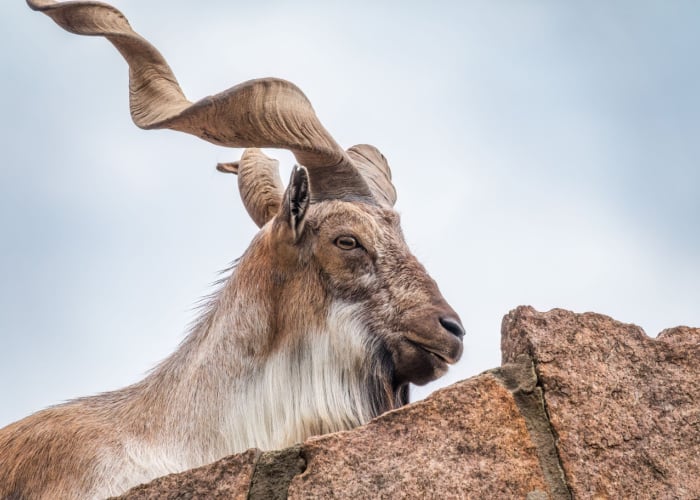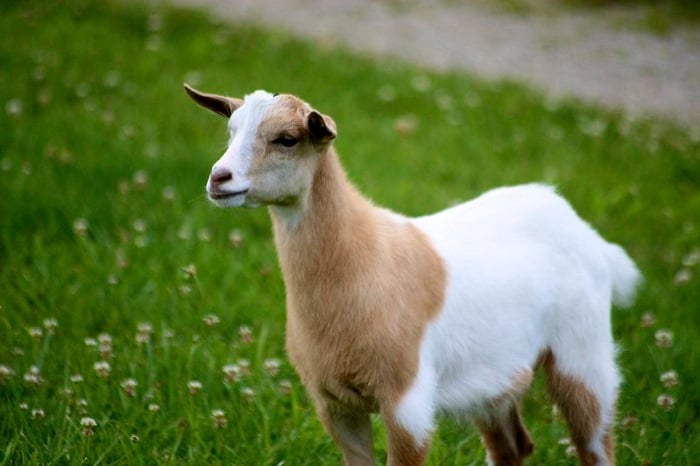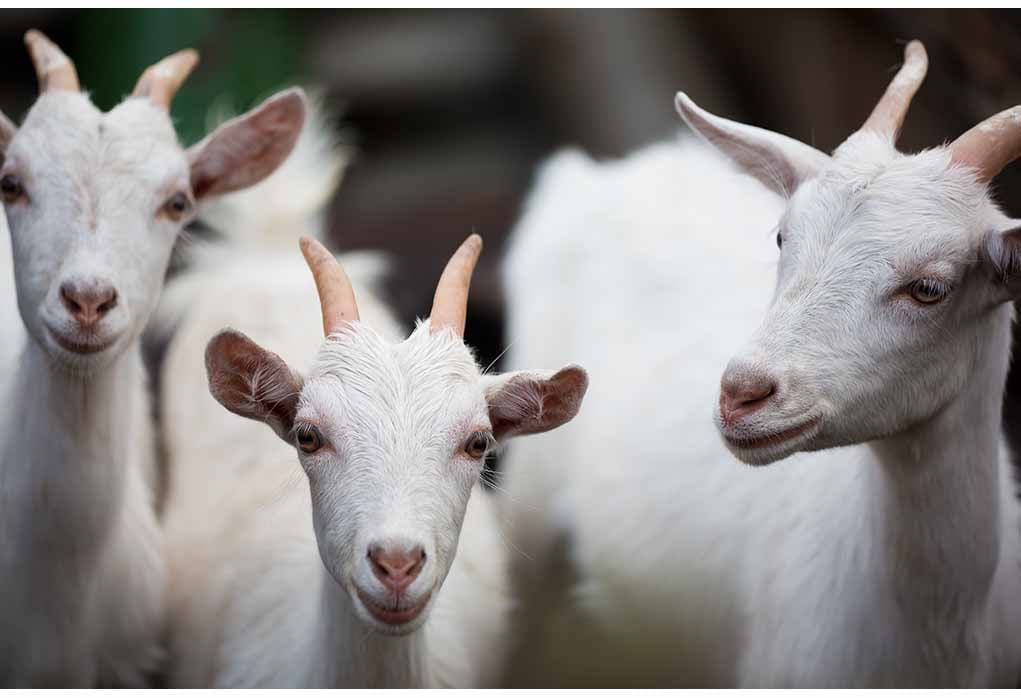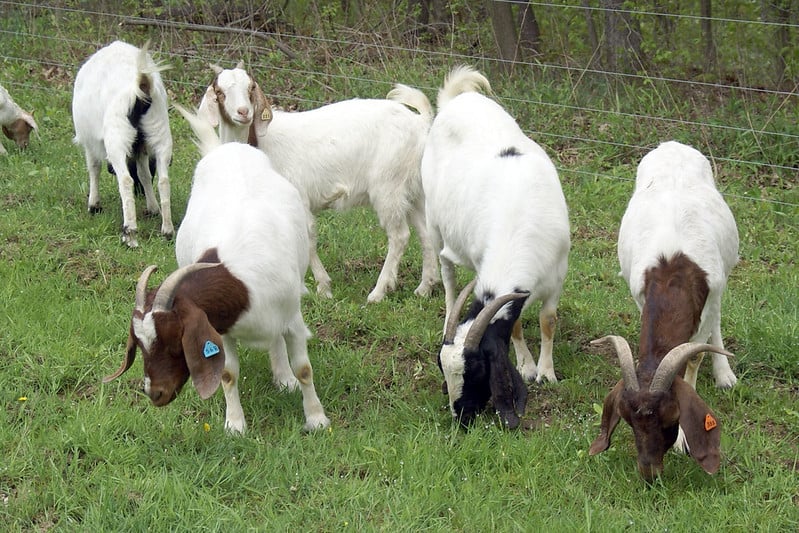Welcome to the fascinating world of wild goat breeds, also called the Capra genus!
From the majestic Ibexes to the agile Turs and the enigmatic Markhor, these extraordinary creatures captivate us with their resilience, adaptability, and sheer beauty.
Join us as we delve into these wild goat breeds’ characteristics, habitats, and remarkable adaptations, showcasing the incredible diversity and wonder of nature’s creations.
10 Wild Goat Breeds To Meet
1. Oreamnos Americanus
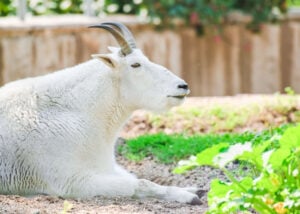
This is the only North American wild goat breed on our list!
They are also one of theleast-studied large Animals in North Americabecause of their remote, hard-to-access habitats.
Mountain goats are found in rugged, mountainous areas of western North America, including coastal regions in Alaska.
They are a type of “rock goat” with short horns that love living in tough terrain.
The Oreamnos Americanus is one of the two large, all-white mammals in Alaska.
They can be distinguished from similar-looking Dall sheep by their striking black horns.
These goats have adapted well to harsh winters with their thick, shaggy coats.
Adult males are around 40% bigger than females at 300 to 285 pounds and have different-shaped horns than their female counterparts.
The does are typically only 180 pounds at the most.
They have specially designed hooves for climbing steep rocks, with a hard outer layer and a soft pad for better grip.
Researchers estimate24,000 to 33,500 of these mountain goats live in southern Alaskaand the coastal mountain ranges of western Canada, especially in the territories.
Though bears and lynxes live in the area and hunt the younger goats, their toughest obstacle is winter.
During winter, heavy snowfalls cover their food, and starvation seriously threatens them.
Their main forages are forbs, low-growing shrubs, sedges, berries, lichen, and hemlock.
2. Capra Aegagrus
Capra aegagrus, otherwise known as the wild goat, is one of the ancestors of the domestic goat, capa hircus.
The wild goat is nearly endangered because of habitat loss and destruction, mostly due to human influence.
Poaching, logging, and competition with domestic livestock are their greatest threats.
他们的自然习惯从土耳其到阿富汗人不等tan and Pakistan.
It primarily lives in these regions’ forests, shrubby areas, and rocky terrain.
Wild goats live in loose herds where their population fluctuates as herd members come and go freely.
Most herds have more does than bucks, with a two-to-one ratio.
Most older bucks will do their best to chase away the younger males, but they’re not always successful.
Bucks start to look for their partners in December and will try to breed until the end of January.
Their pregnancies typically last 170 days, or five and a half months.
Theykidin June or July and usually have one to three babies at a time.
When the kids are born, they can move around almost right away and can run in just a few hours; this helps them survive their natural predators.
After six months, the babies stop drinking milk from their mothers.
Female goats sexually mature at one and a half to two and a half years old.
Male goats mature at three and a half to four years old.
These wild goats live for 12 to 22 years.
There are several subspecies of wild goats, which I’ll cover over the next few sections.
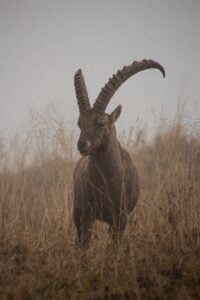
3. Ibexes
Ibexes are wild goat breeds that are classified as males and females based on their horns.
Males have large recurved horns, while females are sometimes shorter or nonexistent.
They range from 150 to 290 pounds, and you can find them across Eurasia, North Africa, and East Africa.
Spanish Ibex – Capra pyrenaica
These goats are native to the Eastern Sierra Nevada, and Carzorla-Segura mountain ranges on the Iberian Peninsula in Spain.
They live at and above elevations of 2,600 feet, typically in forested mountain ranges with many coniferous trees, rock outcroppings, Holm oak trees, and forests with multiple layers of canopy cover.
Spanish Ibex goats have grey to brown shaded coats.
They are three to four and a half feet long and two to two and a half feet tall at the shoulder.
Males weigh up to 170 pounds and have horns up to four and a half feet long– nearly the same size as their bodies.
Most of their diet consists of eating Holm Oak saplings and acorns.
Less than 15% of their diet is made of forbs and grasses in the spring and earlier summer months.
Their only predators are humans, with the exception of foxes and eagles hunting their young kids.
Alpine Ibex – Capra Ibex
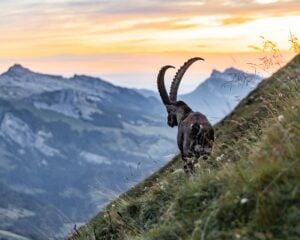
Alpine Ibex goats live in central Europe to northern Ethiopia and then east to Central China.
Most of them live at elevations of 10,000 feet; the males tend to stay higher on rock cliffs in groups of six to eight, though some live alone.
The females are lower during the day, living on rolling hills and hidden in heavier foliage.
They tend to stay in organized groups of ten to twenty does and always have a matriarchal dominant leader.
At night time, the males and females work their way down the mountains into the trees to scrounge for brushy forage.
Most of them are four to four and a half feet long and beige in color, and the males have impressively thick beards.
These goats prefer to be higher in the mountains during the summer and then move to lower elevations to avoid the heavy snow so they can find more food to browse.
Alpine Ibex have to be on the lookout for bears, leopards, wolves, people, and golden eagles– all hunting them.
They may also compete with some domestic goat breeds for food and water sources.
Nubian Ibex – Capra Nubiana
This is the only wild goat that has evolved to live in hot, arid desert-like areas.
They once lived in the mountains but migrated and adapted to live in the coastal regions of northeastern Africa, the Sinai Peninsula, and the Arabian Peninsula.
You are likelier to find them in mountainous gorges, scree areas, and outcrops in hot places with very little vegetation.
他们似乎喜欢远程,陡峭,海拔高cliffs; however, their elevation wildly ranges from sea level to 10,000 feet up.
The does are only a third of the size of the bucks.
Males weigh 154 pounds, while most females only hit 55 pounds at the most, and both are about four feet long.
Bucks grow horns that are up to four feet long; the females only grow to be about a foot long.
These wild mountain-desert goats have sand-tan fur with a white stomach and black and white on their legs.
In the fall, males turn dark brown on their shoulders, necks, chests, sides of the stomach, front of the thighs, and on the upper regions of their back legs.
Males are often solitary during the rut but may stand in bachelor bands for the rest of the year; females stay in herds of ten to twenty others.
An interesting fact about this species is that newborn kids will usually hide the first few days of their life and then rejoin their mothers after they are three days old.
After that, they stay on incredibly rocky and steep-walled cliffs to avoid predators.
It’s often reported that the mothers drop their babies off at unattended canyon nurseries, like Avedat Canyon in Israel.
Here, the babies stay together all day, with their mothers periodically visiting to nurse them.
The kids are unable to follow the mothers out of the canyon, so they stay put until they are older and able-bodied enough to leave.
Some speculate that these baby goat nurseries are unintentional; the kids simply fall into them and are stuck there until they mature and gain the ability to scale these sheer cliff faces.
Most Nubian Ibexes wean at two to three months old.
Siberian Ibex – Capra Sibirica
These wild goats live in several mountain ranges in Central Asia to southern Siberia.
There are a few populations in Afghanistan, Pakistan, Mongolia, and China.
They live at elevations ranging from 1,650 to 16,500 feet; they tend to climb higher in the summer and lower in the winter when the snow is prohibitive.
Bucks are typically five and a half feet tall with five-foot-long horns.
Does are about four feet tall with one to one-and-a-half-foot-long horns.
The females have much slimmer horns than the males.
Siberian Ibexes are typically light brown with white or yellowish-cream colored underbellies.
They also have dorsal stripes that run down to their tails from the center of their necks.
Some will have dark brown patches at random points of their bodies.
This species of goat lives in harems with five to fifteen does, guarded by one buck.
Siberian Ibexes commonly have single kids; it is rare to have twins.
These kids can wean by two months old, but many continue to nurse into their eighth month of life.
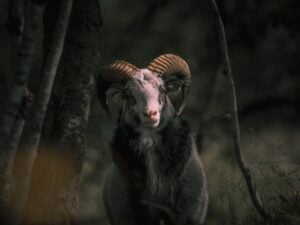
Walia Ibex — Capra Walie
Walia Ibex live exclusively in northern Ethiopia’s mountains.
This entire species lives within the Simien Mountains National Park in Ethiopia.
There, they roam gulleys, gorges, and jagged cliffs.
Many of their deaths are the result of them falling, not predation.
Since they are so close to the Equator but at such a high elevation of 8,200 to 14,500 feet, they have to ensure wild temperature variances.
The mountains are tropical, but daily temperatures range from five degrees Fahrenheit at night to eighty degrees Fahrenheit during the heat of the day.
The does weigh considerably less than the bucks; does are about 176 pounds, while bucks can get up to 275 pounds.
This species has semi-circular horns that may be up to three and a half feet long.
Males are a chestnut brown color; females are a light sandy brown shade that is better camouflaged for their environment.
Both sexes have white underbellies with black and white markings on their legs.
What’s interesting about the Walia Ibex is their suction cup hooves.
They use their concave-shaped feet to scale impressive mountains.
The edges of the hoof are sharp and resilient so that they can travel to more extreme cliffsides.
4. Turs
West Caucasian Tur – Capra Caucasica
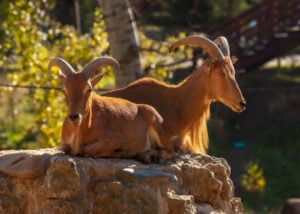
These goats live in a protected area in the western Caucasus Mountains of Georgia and southwestern Russia.
They stay within this million-acre protected area at elevations of 2,600 to 14,000 feet.
Much of the ground they travel is rugged and difficult to navigate.
The lower elevations they use to source their food consist of dense forests, and up from there, they trek through alpine meadows, talus slopes, and permanently snow-covered mountain summits.
Male Turs are four to five and a half feet long, with weights of 220 pounds and horns that span two and a half feet long.
Female Turs are smaller in weight at 140 to 220 pounds but sport similar-sized horns.
These herbivores eat wild grasses and plants at all elevations, usually sleeping the hottest part of the day, then foraging in the mornings, evenings, and overnight.
Researchers have noted that these goats will travel up to twelve miles a day between their sleeping locations on cliffs and feeding spaces down below.
East Caucasian Tur – Capra Caucasica Cyclindricornis
East Caucasian Turs live in the Greater Caucasus Mountain range in Georgia and Azerbaijan – from the Black Sea to the Caspian Sea.
They tend to stay between elevations of 3,200 to 11,000 feet in forested and alpine regions.
The does seem to congregate together in the forests, while the bucks prefer the open grasslands.
The females are 120 pounds or more, with four-and-a-half-foot-long bodies and seven-inch horns.
Males are closer to 300 pounds with six-foot-long bodies and three-foot-long horns.
Both males and females have notably short legs; their chests and barrel-sized bodies comprise most of their height.
These goats have a five-month-long breeding season that usually results in one to two kids per doe.
The does will then wean their babies earlier than most species at only one to two months of age.
These goats will not reach sexual maturity until they are four to six years old.
5. Markhor – Capra Falconeri
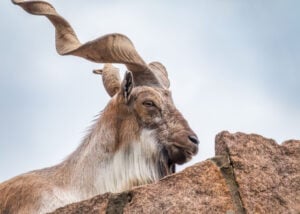
These remarkable goats live in the western Himalayas in the countries of Afghanistan, Pakistan, India, Tajikistan, Turkmenistan, and Uzbekistan.
They stay in elevations between 2,000 and 12,000 feet, where the land is mountainous and covered in scrub forests.
They forage on the pines, junipers, and oaks that grow there.
Males are 240 pounds; females are only seventy pounds at full maturity.
Both have flared corkscrew horns that dramatically twist outward and vary from dark brown to reddish, orange-tan, or reddish brown.
This goat species has a four-and-a-half to five-and-a-half-long pregnancy with one or two kids each.
The kids wean at five to six months old and then become sexually mature at one and a half to three years old.
The males are solitary, while the females congregate in small herds of up to nine.
Their main forms of predation come from lynxes, snow leopards, panthers, and wolves.
Golden eagles will occasionally steal the young.
People hunt them too, but it’s rare for people to make it past the first few mountains in this range.
Because of this, the Markhor goats tend to stay in the central parts of the range, where they won’t encounter many people.
FAQs about Wild Goat Breeds
不同品种的野生山羊从驯化g怎么样oat breeds?
Wild goat breeds are typically smaller and more agile than domesticated goat breeds.
They have adapted to living in rugged and mountainous terrain and can easily navigate steep slopes and rocky terrain.
Wild goat breeds also tend to have longer, shaggier coats and larger horns than their domesticated counterparts.
How do wild goat breeds adapt to their environment?
Wild goat breeds have adapted to their environment in a number of ways.
They are able to survive in harsh and arid environments by conserving water and finding food in areas where other animals cannot.
They can also easily navigate steep and rocky terrain, using their agility and surefootedness to move quickly and efficiently.
What are the threats to wild goat breeds?
The threats to wild goat breeds include habitat loss, hunting, and competition with domesticated livestock.
Climate change is also a growing threat, as it alters the availability of food and water in their habitats.
How are conservation efforts being made to protect wild goat breeds?
保护的努力s to protect wild goat breeds include habitat restoration, captive breeding programs, and anti-poaching initiatives.
Many organizations are also working to raise awareness about the importance of preserving these animals and their habitats.
Can wild goat breeds be domesticated?
While wild goat breeds have been domesticated in the past, they are generally not well-suited for domestication due to their adaptation to living in rugged and mountainous terrain.
Domesticated goat breeds have been selectively bred over thousands of years to be better suited for living in human-controlled environments.
Are there any unique uses for wild goat breeds in agriculture or industry?
Wild goat breeds have been used for their meat, milk, and wool in certain regions where they are found.
However, due to their small size and limited numbers, they are not typically used on a large scale in agriculture or industry.
Some wild goat breeds are also used in eco-tourism, as they are popular among wildlife enthusiasts and nature lovers.
Wild Goat Breeds: Final Thoughts
In conclusion, the world of wild goat breeds is a testament to the marvels of nature’s diversity.
From the rugged Ibexes to the graceful Turs and the majestic Markhor, each breed possesses unique characteristics and adaptations that allow them to thrive in their respective habitats.
These extraordinary creatures remind us of the incredible resilience and beauty found in the animal kingdom.
If you’re interested in learning more about different goat breeds, be sure to check out these posts too!
